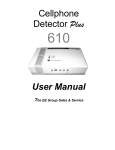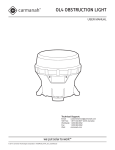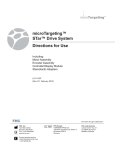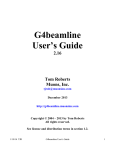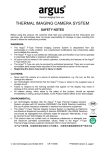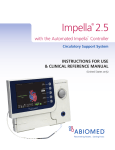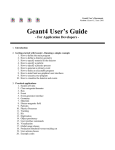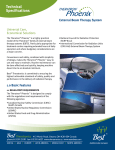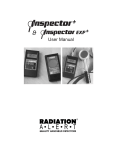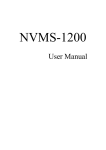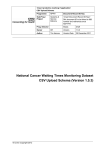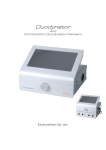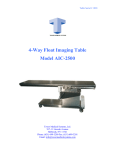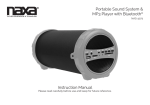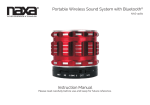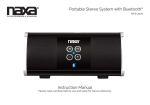Download REGULATORY GUIDE 3 - Texas Department of State Health Services
Transcript
Texas Department of State Health Services Radiation Safety Licensing Branch REGULATORY GUIDE 3.12 GUIDE FOR THE PREPARATION OF LICENSE APPLICATIONS FOR THE INSTALLATION AND USE OF FIXED MULTIPLE BEAM TELETHERAPY SYSTEMS I. Introduction This guide describes the information the Department of State Health Services (DSHS) Radiation Control Program (Agency) staff requires to evaluate license applications for the use and installation of therapy systems such as the Gamma Knife for treatment of humans. The Agency will normally issue a single license to cover the institution's teletherapy program and issue a separate license to cover any other medical usage of radioactive material. This document is intended only to provide general guidance and should not be considered as all the information that maybe required for a particular application. II. License Fees The applicant should refer to Title 25 Texas Administrative Code (TAC) Section (§) 289.204 to determine the fee that should accompany the application. Review of the application will not begin until the proper fee is received by the Agency. The fee may be paid in cash, by money order, certified check, or personal check, made payable to the Texas Department of State Health Services. In submitting an application for renewal of a radioactive material license, the fee should not be submitted until billed by this Agency. A fee is not required to amend a license, unless the amendment changes the category and type of license. If there are any questions, the Agency accounting staff will clarify the fees. III. Completing The Application The application form used for nuclear medicine applications (BRC Form 252-2a) is also used for therapy applications. The applicant should provide complete information to expedite the review of the license application. Two copies of the application should be submitted to the Agency, and a third copy should be retained, since the applicant will be bound by the statements made in the application once the license is issued. Regulatory Guides are issued to assist applicants and licensees/registrants in developing operational procedures acceptable to the Department of State Health Services, Radiation Safety Licensing Branch (agency), that are compliant with specific sections of Title 25 Texas Administrative Code Chapter 289. Regulatory Guides are NOT substitutes for regulations and compliance with them is not required. Methods for compliance with regulations different from those set out in guides will be acceptable if they are considered by agency staff to provide for public health and safety and demonstrate compliance with regulations. Comments and suggestions for improvements in Regulatory Guides are encouraged. Letters containing comments and suggestions should be sent to the Manager, Radiation Safety Licensing Branch, Department of State Health Services, 1100 W. 49th Street, Austin, Texas 78756-3189. Regulatory guides may be reproduced or may be obtained by contacting the agency at (512) 8346688 or accessing the agency web page at www.dshs.state.tx.us/radiation 1 of 15 All entities wishing to obtain a radioactive material license must complete a Business Information Form BRC Form 252-1 and attach it to the application. Items 1 through 4 - Self-explanatory. Item 5 - Procedures involving the application of radiation to or on humans must be ordered and supervised by a physician licensed and trained in the medical use of radiation. Acceptable training and experience are discussed in Item 10 and specified in Appendix A. Item 6 - The Radiation Safety Officer (RSO) is the person who will be responsible for the radiation safety program, maintain the license and associated records, and be the primary contact with the Agency in administering the license. The RSO must have the authority to enforce radiation safety policy, suspend activities deemed unsafe, and require remedial action when necessary. The RSO is usually a medical physicist or one of the authorized users listed in Item 5. See Item 10. Item 7 - Under "Additional Items Desired," complete as follows: A. List radioactive isotopes, including any uranium to be used as shielding material. B. Indicate "Sealed Source", source manufacturer(s), and the model number(s) of the source(s) to be installed. C. Specify the maximum number of curies (not RHM) each of the sources will have and the total number of sources. If more than one set of sources is required to be present when sources are exchanged, the number of sources and total activity should include all of the sources. D. Specify the therapy system manufacturer and model name and/or number. (See Appendix B for sample form.) Item 8 and 9 - Self-explanatory. Item 10 - Training of Authorized Physicians, Radiation Safety Officer, Technologists. A. Individuals who will use the therapy systems and perform stereotactic localizations for treatment of humans must be licensed by the Texas State Board of Medical Examiners. The using physicians must be therapeutic radiologists or therapeutic roentgenologists with 200 hours of training in basic radioisotope handling techniques and three years of experience in clinical therapy with sealed sources. A preceptor statement (pages 3 and 4 of BRC Form 252-2a) should be submitted to verify the training in radiology. Certification by the American Board of Radiology in radiology, roentgenology, or therapeutic radiology will be accepted in lieu of a preceptor's statement. Additional machine specific requirements for physician training appear in Appendix A of this guide. 2 of 15 B. Neurosurgeons - See Appendix A of this Guide. Note: Applications for renewal of existing licenses need to include this information only for physicians who are to be added to the license. C. Physicists - See Appendix A of this Guide. D. Radiation Safety Officer (RSO) - The RSO is responsible for the day-to-day radiation safety program. The RSO maintains all records required by agency rules and is also the primary contact with the agency on matters pertaining to the license and the use of radioactive material. The RSO's training and experience with the types and quantities of radioactive material for which a license is being requested must be submitted. Qualifications may be found in §289.256(h). E. Technicians - Describe the technician training, testing and supervisory program as indicated below. Also see Appendix A for training guidelines. 1. Describe the minimum training technicians must have before they will be allowed to operate the system. If training is not verified through recognized certification, describe the subjects, classroom hours of formal training and the supervised on-the-job experience to be required. 2. Indicate how performance will be gauged in the training program. Describe the tests and on-the-job performance evaluations that will be given to determine if the trainee has satisfactorily completed the educational program. Include the periodic training, testing, and evaluation that will be given thereafter. 3. Describe how the technicians will be supervised on the job. Confirm that the performance of technicians will be observed by a licensed user to verify that established procedures are being followed. F. Ancillary Staff - Describe the instructions and training to be given to ancillary personnel who will work in the vicinity of the therapy system, e.g. clerical, nursing, security, house keeping personnel. (See Appendix A.) Item 11 - Facilities A. Facilities - Submit a floor plan drawing and front and side elevation drawings of the therapy system room as configured for patient treatment. Drawings should be to scale or sufficiently annotated to indicate thickness of barriers, type of barrier material, and the location of entranceways, windows, conduits and other penetrations in the barrier material. The location of the therapy system inside the room and the distances from the sources to adjacent areas outside the therapy room should also be indicated. Specify any restrictions needed because of radiological protection requirements. 3 of 15 Indicate calculated maximum radiation levels in all accessible areas adjacent to, above and below the therapy room directly on the drawings or on a supplementary sheet adequately keyed to the drawings. Occupancy factors should be discussed, determined, and assigned to each of these areas. [See "National Council on Radiation Protection (NCRP) Report No. 49.] Each area set apart as a "restricted area" must be indicated by the applicant. Any area that is not restricted must meet the requirements for radiation levels in unrestricted areas in accordance with 25 TAC §289.202(n). Describe the method used to determine the shielding requirements for the facility. Describe the results obtained based on workload, use factor, occupancy, and distance for each configuration of the therapy system that will occur in the course of routine patient treatment, considering contributions to radiation fields An each adjacent area that arise from primary, leakage, and scattered radiation. These results should be expressed in terms of the thickness required for each barrier material in each wall or direction. A comparison should be provided between these requirements and the actual barrier thicknesses as designed and/or installed. The applicant should periodically check the occupancy of each area, make radiation surveys, and keep records of such surveys to demonstrate that the maximum permissible exposure values will not be exceeded. Give a description of the electrical interlocks, warning lights, or other devices used on all accessible entranceways to the treatment room. The treatment room must be equipped with interlocks that either will cause the treatment to cease immediately (and the shielding door to close) when any entrance door is opened, or that will not allow entry from outside except by keyed override, when the shielding door is open and treatment has begun. Free exit from inside, or a "Scram" switch, must be provided for the latter style of interlock. The interlocks must be connected so the treatment cannot be resumed until all entrance doors are closed and the therapy control reset at the console (25 TAC §289.256(dd)). It is also recommended that clearly visible warning lights, which indicate when the therapy unit is "on" or "off", be mounted near the entrances to the treatment room. Include a description of the warning signs to be posted on or beside the entrance doors to the therapy room. Provide a description of the system to be used to continuously view and communicate with the patient. If television is to be used, specify that treatment shall cease when the television is inoperative and no back-up system is available. B. Temporary Hot Cell for Source Loading - Submit a floor plan drawing and front and side elevation drawings of the temporary hot cell, if necessary for source 4 of 15 loading, and the therapy system room as configured for source loading. Drawings should be to scale or sufficiently annotated to indicate thickness of barriers, type of barrier material, and the location of entrance ways, windows, conduits and other penetrations in the barrier material. The location of the therapy system inside the hot cell, the shielded source storage area, and the distances from the sources to adjacent areas outside the hot cell should also be indicated. Specify any additional restrictions of surrounding areas needed to implement the radiological protection plan associated with the hot cell/treatment room loading configuration and design. Indicate calculated maximum radiation levels in all accessible areas adjacent to, above and below the hot cell and therapy room directly on the drawings or on a supplementary sheet adequately keyed to the drawings. Any expected variation of radiation fields with height above the floor (up to seven feet above the floor for occupiable areas) should be noted, especially in front of the hot cell where high fields may exist because of manipulator arm penetrations. Occupancy factors should be discussed, determined, and assigned to each of these areas. (See NCRP Report No. 49.) Each area set apart as a "restricted area" must be indicated by the applicant. Any area that is not restricted must meet the requirements for radiation levels in unrestricted areas in accordance with 25 TAC §289.202(n). Calculations should be based on the maximum activity authorized, positioned in an unshielded, "worst location" configuration. Describe the method used to determine the shielding requirements for the facility; composition, size and thickness of shielding materials. Indicate and illustrate how components of barriers are to be configured to prevent streaming of radiation along mating surfaces. Indicate any special equipment to be used (i.e., heavy machinery, hoists, remote manipulators and viewing devices, such as windows, television or mirrors) and in the case of lifting devices, how these will be tested to the full capacity required, before sources are brought in to the facility. The applicant should check the occupancy of each area, make periodic radiation surveys, and keep records of such surveys to demonstrate that the maximum permissible exposure values will not be exceeded. C. See Appendix C. Item 12 - Operating, Safety and Emergency Procedures A. Radiation Safety Procedures - These procedures should include both the normal operating procedures and emergency procedures. The radiation safety procedures should contain: 1. Duties of the RSO. 5 of 15 2. A list of person(s) who are authorized to use the unit for treatment, for research or calibration, and for maintenance purposes. One of the authorized users on the license must be present when the therapy system is activated; when maintenance is performed; or when technicians operate the device. 3. Procedures for monitoring personnel exposure to radiation. 4. Procedures for testing the sealed sources for leakage every six months. If the leak tests will be analyzed at the facility, Regulatory Guide 5.1, "Guide for the Preparation of Leak Test Applications," may be obtained from the Agency. Acceptable area to be wiped is the outer convex surfaces of the collimator helmets and the exterior interface line between the hemispherical shield and the base. 5. Provisions for calibrating radiation survey instruments. (Regulatory Guide 5.2, "Guide for the Preparation of Survey Instrument Calibration Applications," may be obtained from the Agency.) 6. A method of securing the therapy system when left unattended. 7. Instructions in case of a malfunction of the therapy system or associated safety equipment. Patient removal and personnel exposure safeguards should be discussed in detail. A schedule for practicing those emergency procedures that do not require significant personnel exposure should be given. Emergency instructions should also include cessation of treatment until all malfunctions are corrected. When the malfunction requires cessation of treatment for 24 hours or more, the instructions should include notification of the Agency. 8. A schedule for conducting full calibration of the therapy system, at intervals not to exceed twelve (12) months, for performing radiation surveys of the restricted and unrestricted areas, for testing safety devices, verifying proper system operation, and for inspecting/servicing the therapy system. 9. See Appendix D. 10. Emergency Plan. (a) Enclose a copy of the emergency plan. A copy of this plan must be posted in a conspicuous place near the therapy control panel, and all personnel involved should be instructed in its procedures. The emergency plan should describe action to be taken in the event of any anticipated emergency, such as failure of the "on-off" mechanism, patient/helmet drive system, shielding door drive, etc. The plan should include provisions for safe removal of the patient. 6 of 15 (b) Confirm that emergency procedures not requiring significant personnel exposure will be practiced at six month intervals or less and that records of attendance and/or performance will be kept for review by the Agency. (c) Confirm that two persons, who have received training in emergency procedures, will be present whenever the unit is in use. 11. Give the name of the person who will perform the full calibration of the therapy unit and who will conduct the therapy facility radiation surveys and acceptance testing. (See Appendix B.) A resume of the individual's training and experience should be included, if not previously submitted. 12. Describe area security safeguards and the method of controlling occupancy of all restricted areas. B. Radiation Safety Procedures for Source Loading - These procedures should address radiation safety during source loading. 1. Duties of the RSO. This should include coordination with construction and installation crews, security personnel for area restriction, and personnel conducting area surveys and wipe tests. A method of communication between such individuals and the RSO from a central point during source loading procedures should be described. The RSO should be present continuously when sources are exposed in the hot cell. 2. A description of person(s) authorized to install the sources in the unit, including general training and experience in handling high-activity sources, and specific training and experience in hot cell construction and for loading of the device to be authorized. If the persons are specifically licensed to perform such operations by an Agreement State or the U.S. Nuclear Regulatory Commission and a copy of the license is submitted, this description may be omitted. Provide manufacturer's concurrence if the individuals are third party contractors. A knowledgeable person must be present to supervise construction and installation personnel at all times during hot cell construction and machine installation. 3. Procedures for monitoring personnel exposure to radiation. This should include National Voluntary Laboratory Accreditation Program (NVLAP) approved devices as well as pocket dosimeters. Describe quality assurance checks on pocket dosimeters, procedures for assigning and collecting the devices, and the range of dosimeters to be used. 4. Procedures for testing the sealed sources for leakage upon installation. If the leak tests will be analyzed at the facility, Regulatory Guide 5.1, "Guide for the Preparation of Leak Test Applications," may be obtained from the Agency. Describe how wipes will be collected, removed from the hot cell, identified, analyzed and results recorded. 7 of 15 5. List the make/model number of the calibrated radiation survey instruments to be available for use during source loadings. Indicate the sensitivity range, energy response range and types of detectors used with each. At least one survey meter should be capable of responding correctly in fields up to 25 R/hr. 6. A method of securing the hot cell access ways (including the remote manipulators) when the hot cell is unattended and sources are present. 7. Instructions in case of a malfunction, unusual event, or emergency, including failure of the hot cell shielding or any safety equipment, during source loading. The instructions should include cessation of activity until all malfunctions are corrected and notification of the Agency is made, as required by 25 TAC §289.202(xx). 8. An assignment of personnel and a description of locations for performing radiation surveys of the restricted and unrestricted areas, and testing safety devices for proper operation, prior to and as necessary during source loading operations. Testing of communications should be completed before sourceloading operations require the sources to be unshielded. 9. Confirm that radiation field surveys for adjoining unrestricted areas will be performed and recorded during each day of source loading and that results recorded to assure compliance with 25 TAC §289.202(n). 10. Confirm that a shielded cask, separate from the main transport cask, which is suitable for containing sources or sources stuck in sleeve assemblies, will be present during source loading, to safely store any sources or assemblies damaged during loading. 11. In the event of source leakage, or if contamination is found in excess of 0.005 uCi, confirm that operations will be suspended and that notification of the situation will be provided to the Agency within 24 hours. Resumption of activities will require Agency approval. 12. In the event of a source becoming lodged in a sleeve or bushing, confirm that the stuck source and assembly will be taken to a licensed processing facility for handling and repair, rather than attempting emergency repair procedures on site. 13. If an auxiliary crane is used that requires penetration of the top of the hot cell, discuss how exposures to the rooftop and any personnel assisting in the area, including the crane operator, will be controlled and monitored. 8 of 15 14. Confirm that full load testing will be performed and documented on all the lifting assemblies after their installation and prior to their use during source loading. Item 13. Radiation Detection Instrumentation - In addition to describing portable radiation survey instrumentation (see 10.B.2.e.), include a description of the beamon room radiation monitor that will be used to independently indicate when the sources are exposed (the shielding door is open) by detecting scatter radiation. This monitor must operate correctly during a power failure. Alternatively, indicate how observation of the position of the shielding door is possible, immediately upon room entry, and from every occupiable location within the room. Item 14 - Financial Qualification and Financial Assurance - See 25 TAC §289.252(gg) to determine if financial assurance must be provided. Unless licensed authorizations include large amounts of long-lived radioactive material (i.e., half-lives of greater than 120 days), financial assurance is not required and financial qualification can be established via self-attestation on BRC Form 252-1, Business Information Form. Item 15 - The application must be signed and dated by the applicant or an individual duly authorized by the applicant to act for or on the applicant's behalf. Unsigned and undated applications will be returned to the applicant. Retain one copy for your files and mail the license applications and appropriate fee to: Texas Department of State Health Services Radiation Safety Licensing Branch Medical and Academic Licensing Program 1100 West 49th Street Austin, Texas 78756-3189 9 of 15 Appendix A Recommended Radiation Safety Training for Individuals Involved with Teletherapy Systems Such as the Gamma Knife A. Staff: Nurses Neurosurgeons Other physicians Topic: Training should provide basic radiation safety training. 1. Title 25 TAC §289, exposure limits, rights and responsibilities as radiation workers. 2. Personnel monitoring and use of film badges. 3. Radioactivity and radiation exposure. 4. Radiation protection concepts - shielding, time and distance. 5. ALARA 6. Risks associated with low-level radiation exposure. 7. Use of radiation survey instruments including the room monitor. 8. Emergency procedures Duration: 4 hours Note: Neurosurgeons should have prior competency in stereotactic localization for open surgery. An additional two or three weeks in clinical uses (i.e., supervised evaluation and treatment of patients) should be documented. B. Staff: Radiation Oncology Technologists Nurses with prior training in radiation safety Topic: Training should introduce the specific machine (Gamma Knife) to radiation workers. 1. Description of the therapy system. 2. Radiation levels in the therapy room when the therapy system's shielding door is closed, and when it is open, during patient treatment. 3. Review of radiation monitors including the independent room monitor. 10 of 15 4. Review of interlocks and other safety features. 5. Review of emergency procedures. Duration: 2 hours Note: If technologists are to operate the unit, comprehensive training on features in the operations manual must be provided. Time in training should include observation and operation of a therapy system and classroom hours to cover the content of operations manual. C. Staff: Housekeeping staff Security officers Administrators Topic: Training should provide a description of the therapy system, to identify occasions when entry into the treatment room is permissible, to familiarize trainees with warning systems which indicate unsafe conditions. 1. Description of the therapy system. 2. Radiation levels, compared to occupational and non-occupational allowable levels, with the therapy system's shielding door open and closed. 3. Location and operation of visible warning lights and radiation monitors. 4. Occupying or entering treatment room only when the therapy system's shielding door is in a closed position. Duration: 1 hour D. Staff: Authorized using physician - Radiation Therapist Topic: Training should provide instruction in stereotaxis on the unit to be authorized. Duration: Based on workload, time may vary in the instruction and experience in the treatment of humans. Observation and treatment of at least 10 patients should be accomplished under supervision of an authorized user. E. Staff: Therapeutic Radiological Physicist Topic: Training should provide knowledge and experience in observation of procedures, dose planning, installation and acceptance testing of the system. Duration: Two weeks on-site study at a licensed therapy system facility. 11 of 15 Appendix B Recommended Acceptance Tests for the Leksell Gamma Unit (Gamma Knife) Acceptance Test I Documentation 1. Users manual including: a) Instructions for handling. b) Instructions for performance of vital controls. c) Instructions for maintenance. d) Instructions for fault finding. e) Set of drawings for maintenance and service. 2. Measurement protocol on the direction of each beam channel towards focus. 3. Measurement protocol for all collimators, collimator bushings and capsules and bushings for the Co-60 sources. Protocol should include maximum deviation for inner diameter, outer diameter and throw for each bushing. Mechanical aqendaagenda 4. With a test tool fixed in the helmet, straightness of the trunnions for the head fixation frame should be checked. 5. Correct positioning of the helmet in the central body should be controlled in a positive manner (with a metal contact plate, which is positioned on a contact surface of the helmet). Positive indication of positioning should be demonstrated. Specialized instrumentation for setting of the micro-switches on the helmets may be used. 6. Demonstration of reproducibility of helmet position settings as commanded by the main controls. 7. If the Gamma Unit's helmet or other patient positioning equipment malfunctions, the patient must be automatically brought out and the shielding door be closed by manual means. This also applies in case of power failure. Such operations shall be completely tested. 12 of 15 8. The hydraulic system of the couch and shielding door should be shown to be manually operable. 9. In all common emergency situations it must be possible to bring the patient out of the radiation area in less than 2 minutes and this should be demonstrated for each common emergency type (power failure, malfunction of positioning equipment, etc.). 10. The treatment time is to be controlled by two independent timers that are also to indicate elapsed treatment time, in the case of power failure. 11. Damage or displacement of electrical cables, connections or mechanical components accessible to the patient under treatment shall not jeopardize the termination of the treatment in progress. Inadvertent or deliberate patient motion shall not be likely to cause significant damage to any part of the Gamma Unit itself or to displace the cerebral target point. 12. The unit shall be self-protected against the likelihood significant damage from mishaps involving routine hospital equipment such as collisions with the couch, operating table or radiation unit by carts, stands, gurneys, etc. 13. Trial runs should be performed to check mechanical installations: a) Couch and shielding door system works repeatedly (x20) and correctly when commanded by main controls. b) Demonstration and test of helmet exchange device with all helmets. c) Mechanical cycle of patient insertion, with a weighted couch. Acceptance Test II Radiophysical AqendaAgenda 14. Dose rate: The dose rate shall be determined at the intersection of the axis of the beams defined by the 4 mm collimator system. The dose rate shall be measured in a spherical water equivalent phantom, 16 cm in diameter and placed with its center at the beam intersection. 15. Spatial dose distribution: measured and calculated dose profiles (i.e. total spatial dose distributions) should be compared under identical conditions. The calculated dose profiles should be based on isodose distributions calculated by the dose planning system. The measured and calculated dose profiles at Full Width Half Maximum (FWHM) should not differ more than 1 mm for the 4 mm collimator system. 13 of 15 16. Radiation protection: The general construction of the Gamma Unit and the design of its external shielding shall conform to NCRP 49. 17. A report on dose rate measurements should be presented. 18. The documentation of the Gamma Unit should include a catalog of source identification. The measured activity and the location of each individual Co-60 source should be given. Medical and General AqendaAgenda 19. Simulated operations should be performed as a check on various components and safety features. A complete program, including positioning, collimator exchange and superpositioning of therapy treatments should be included. This performance testing should also include demonstrations of: a) Power failure during irradiation: to show automatic removal of couch and manual closure of shielding door; information about elapsed time and state of treatment to appear on main the control. b) Hydraulic pump failure during treatment: to show removal of couch and closure of shielding door; information about elapsed time and state of treatment to appear on the main control. c) Emergency stop of treatment by responsible operator: to show automatic removal of couch and manual closure of shielding door; information about elapsed time and state of treatment to appear on the main control. d) Termination of treatment caused by controls failure: to show automatic removal of couch and closure of shielding door; information about elapsed time and state of treatment to appear on the main control. e) Halting of couch movement in to or out of the radiation unit as commanded by main control: to show stopping of couch; information about the state of treatment to appear on the main control. 14 of 15 Appendix C REQUIREMENTS AFTER LICENSURE Prior to initiation of a treatment program, and subsequent to each installation of therapy system sources, radiation surveys and tests shall be performed in accordance with the following: A. A radiation survey shall be made of: (i) The therapy system source housing. The maximum and average radiation levels at one meter from the nearest therapy system source with the device's shielding door closed shall not exceed 10 milliroentgens per hour and 2 milliroentgens per hour, respectively, for any of the device's sources, when all sources are installed. (ii) All areas adjacent to the treatment room, with the device's shielding door open. The survey shall be performed with a phantom in the primary beam of radiation and shall clearly establish: (a) That radiation levels in restricted areas are not likely to cause personnel exposure in excess of the limits specified in 25 TAC §289.202(f). (b) That radiation levels in unrestricted areas do not exceed the limits specified in 25 TAC §289.202(n). B. Tests shall be made to determine proper operation of: (i) Electrical interlocks on entrance doors to the therapy treatment room. (ii) The therapy source "on-off" indicators, both at the source housing and on the therapy system control panel. (iii) The therapy system treatment-timing device. (iv) The radiation field room monitor, warning lights, safety switches, alarms, etc. C. A report of the results of the above surveys and tests shall be sent to the Agency not later than thirty (30) days following installation of therapy sources. D. Inspection, servicing and maintenance shall be performed in accordance with the procedures and schedules contained in the user's manual provided by the manufacturer, and as required by the license. Reports of such maintenance are to be forwarded to the Agency at five (5) year intervals. 15 of 15















